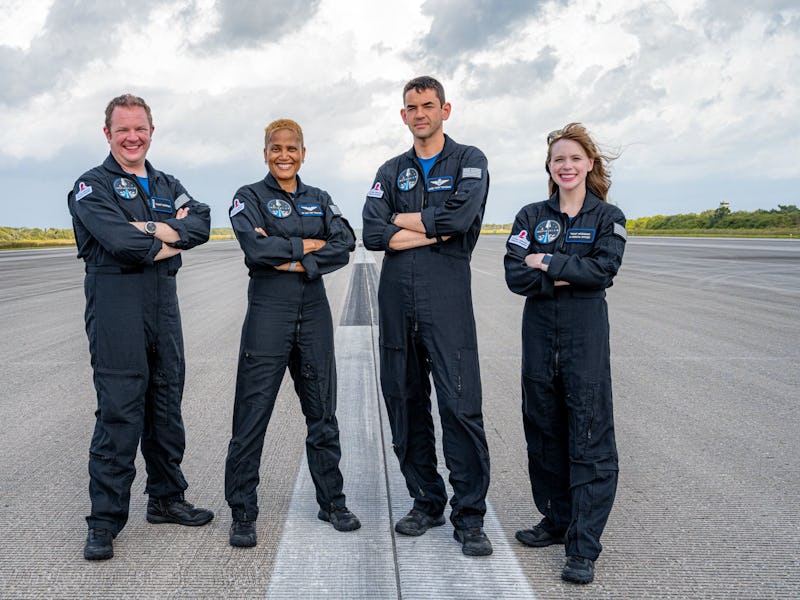Inspiration4: The 7 most fascinating tidbits you may have missed
SpaceX's first all-civilian mission has taken off. Here's what you may have missed.

Liftoff! SpaceX’s all-civilian mission, Inspiration4, launched from NASA’s Kennedy Space Center in Florida on Wednesday.
The mission is perhaps one of the most important in the company’s history. It’s the first launch from a private company without any national agency involvement, marking a new era of private spaceflight with greater accessibility to all.
Musk Reads, an Inverse newsletter dedicated to the latest in space travel and related topics, spoke to key figures around the launch to dig into the details. We spoke to the passengers, documentary makers, researchers, and more.
Here are seven key tidbits we learned:
7. Pizza will be served on board
The crew will spend three days orbiting the Earth. Sian Proctor, a geoscientist and one of the four passengers, tells Inverse that she will get to eat pizza on board during her trip — a long-standing dream of hers.
Want to find out more about Sian Proctor’s hopes for the mission? Read the full interview here.
6. It should be more straightforward than SpaceX’s other crewed missions
For SpaceX’s three previous crewed missions, the company had to reach the International Space Station. That meant the launch had a window of just one second — missing that window would mean a long delay.
Fortunately, Inspiration4 doesn’t suffer from the same issues, explains Jonathan McDowell, an astrophysicist at the Harvard and Smithsonian Center for Astrophysics.
“It is simpler than an ISS mission — both in terms of scheduling (no need to target a particular orbital plane, so none of that one-second launch window stuff) and in terms of safety,” McDowell tells Inverse. “Rendezvous and docking is a tricky thing, with, of course, the risk of collision if you do it wrong.”
Want to find out more about how the mission itself works? Read the full interview here.
An artist’s impression of the SpaceX Crew Dragon capsule.
5. The mission demonstrates that space is open to all
This is SpaceX’s first crewed mission without NASA’s involvement. Richard B. Cooper, vice president of strategic communications and outreach for Space Foundation, tells Inverse that this marks a clear departure from the earlier sixties-era space race.
“It is changing all the previous rules that were held by generations before, that this is something that only the government or the military could do,” he says.
Want to find out more about what the mission means for opening up space? Read the full interview here.
4. Civilian missions were always part of the plan
NASA employed SpaceX and Boeing to develop a means to send NASA astronauts to and from the ISS. But Garrett Reisman, former NASA astronaut who managed the SpaceX team that developed the Crew Dragon, says that non-NASA missions like these were always part of the overall vision.
“Back when I first started at SpaceX, I remember having lots of meetings with NASA as we talked about the Commercial Crew program about, hey, we can use these vehicles for other missions,” Reisman tells Inverse. “Not just for NASA astronauts, but private citizens.”
Want to find out more about how Crew Dragon came together? Read the full interview here.
3. The mission badge has a fascinating connection to Apollo 11
SpaceX's Inspiration4 badge.
The group’s mission badge has no names on it. That isn’t always the case — SpaceX’s Crew-2 mission in November 2020 included all the names — but the Apollo 11 mission in 1969 that sent the first humans to the Moon also lacked any names.
“I think that is a powerful testament to spaceflight in general,” says Richard B. Cooper, vice president of strategic communications and outreach for Space Foundation. “It is not just about one individual.”
Want to find out more about the fascinating connection? Read the full interview here.
2. The documentary takes its inspiration from sports
Jason Hehir is the director of Countdown: Inspiration4 Mission to Space, the five-part Netflix documentary that chronicles the mission and brings it to a new audience. He tells Inverse that the documentary was filmed similar to his previous work: 24/7, a HBO sports documentary filmed as events unfolded.
“That was a real-time follow documentary, where we were shooting stuff right up until the night before shows aired,” Hehir says. “It was very much, in the true sense of the term, real-time.”
Want to know more about Hehir’s documentary and how the show came together? Read the full interview here.
Jared Isaacman standing in front of a recovered SpaceX Falcon 9 rocket.
1. Jared Isaacman does not regret going beyond the ISS
There’s a moment in the Countdown documentary where Jared Isaacman, founder of Shift4 Payments and the passenger that’s funding the mission, pushes the team to send the Crew Dragon capsule higher than ever. Instead of flying to the 254-mile altitude of the ISS, the capsule will now fly to around 335 miles.
While it seemed daring at the time, and members of the team voiced their reservations during the documentary, Isaacman suggests to Inverse that he has no regrets.
“I wish we could have pushed them even farther,” he says.
Want to find out more about Isaacman’s hopes for the mission? Read the full interview here.
Want to get more tidbits like these? Subscribe to our exclusive newsletter, Musk Reads+, featuring in-depth interviews and analysis on electric cars, space travel, clean energy, and more.